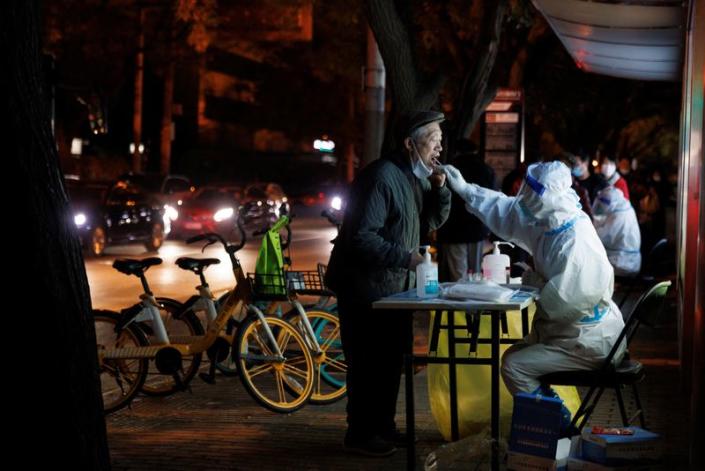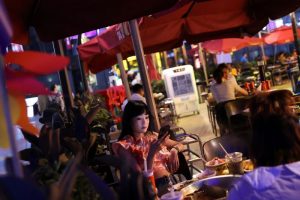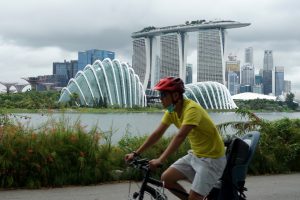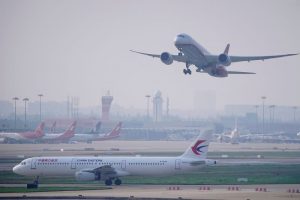China’s Covid cases rose again on Tuesday, with fears growing that district lockdowns could expand in Guangzhou amid the cooler weather.
The infection count in the southern manufacturing hub – a city of close to 19 million people – has just passed 5,000 for the first time.
Cases have also been rising in the capital Beijing, despite many other cities scaling back routine testing after authorities announced measures last week aimed to ease the impact of the country’s stringent coronavirus curbs.
China is scrambling to limit the damage of its zero-Covid policy nearly three years into the pandemic, as the latest in a spate of dismal economic reports showed retail sales fell in October and factory output grew more slowly than expected.
The country faces a delicate transition that may require the purchase of foreign vaccines or anti-Covid drugs and concessions to cool public concern when further changes are made.
There were reports today of chaotic scenes in Guangzhou’s Haizhu district late on Monday night with crowds of citizens crashing through Covid barriers and marching through the streets. Videos posted on Twitter and Weibo allegedly showed scenes of public resentment over Covid restrictions with citizens remonstrating with workers in white hazmat suits.
There have been similar problems in other cities and countries. A Covid outbreak at the massive Foxconn plant in Zhengzhou last month sparked similar problems, with many climbing fences and workers fleeing.
While many residents have expressed guarded optimism after Friday’s announcement that some of the stringent Covid policies would be eased, concerns grew this week over the worsening outbreaks and there was confusion as some cities halted or adjusted regular testing.
“The infection curve of Guangzhou is tracking the pace of Shanghai’s March-April outbreak, raising the question of whether a city-wide lockdown will be triggered,” JPMorgan analysts wrote, referring to Shanghai’s two-month lockdown this year.
“It would become a testing point regarding the government’s determination to push for the relaxation of Covid control measures,” they said.
ALSO SEE:
China’s Economy Slows as Retail Sales, Factory Output Slip
China reported 17,772 new local Covid-19 infections for November 14, up from 16,072 new cases a day earlier and the most since April, with major cities including Chongqing and Zhengzhou among the worst-hit.
JPMorgan estimates that cities with more than 10 new cumulative cases in the past week are home to 780 million people and account for 62% of GDP – roughly triple the levels seen at the end of September.
On Monday, Beijing’s most populous district of Chaoyang, where most of its cases are located, moved some testing sites closer to residential compounds.
While that increased the overall number of sites, it also led to long waiting times in many cases, fuelling frustration, as many workplaces and other venues still require negative test results from within 24 hours.
On the Twitter-like Weibo, a hashtag on testing booth closures was flooded with critical comments on Monday night before being censored: “What are working people supposed to do?” wrote one Weibo user. Another asked: “What kind of brain came up with this policy?”
On Tuesday, state broadcaster CCTV said Chaoyang district was adding more testing sites, including near office buildings.
Beijing reported 462 new infections for Monday, up from 407 a day earlier.
Under China’s new rules, testing efforts are to be more targeted, easing what has been a significant financial burden on cities.
Big Vaccination Effort Still Needed
Friday’s easing announcement sparked a rally in stocks on hopes that China is signaling plans to end a policy that has all-but-shut its borders and caused frequent lockdowns, possibly starting after the annual session of parliament in March.
But experts warn that full reopening will require a massive vaccination booster effort, given low levels of herd immunity resulting from China’s isolation during the pandemic.
It will also require a change in messaging, they say, in a country where catching Covid is widely feared.
In Shanghai, which has been reporting relatively low infection numbers, including 16 for Monday, entire apartment blocks were still being sealed off and the Shanghai Disney Resort has been shut since October 31 after a visitor tested positive for Covid.
While the central government has urged a more flexible approach to controlling outbreaks, local authorities still have wide leeway to lock down buildings they assess as high risk
“The rules are very clear so why is our building shut?” asked a Shanghai retiree whose building was sealed off with tape on Monday morning after a “close contact” had been taken away and quarantined.
Shijiazhuang City-Wide Testing
But the northern city of Shijiazhuang, which reported more than 500 infections on Sunday, has halted city-wide testing and is no longer checking test results for using public transport, although passengers still must scan in with a mobile phone app, according to state-backed media outlet Jiemien.
Guangchang county in the eastern province of Jiangxi said that it canceled community testing it had planned for November 13 and 14 after tests conducted November 8-10 were all negative.
- Reuters with additional editing by Jim Pollard
NOTE: This report was updated with further details on November 15, 2022.
ALSO SEE:
Shanghai Disneyland Hit by Covid, Foxconn Quadruples Pay
China’s Guangzhou Among 41 Cities With Covid Curbs in Place
Warren Buffett’s Berkshire Reveals $4bn Stake in TSMC
























